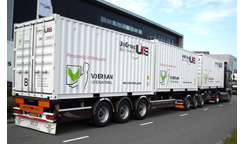Subscribe to the Voerman Group newsletter and read about the latest developments and innovative solutions.
Long Combination Vehicles (LCVs) allowed in The Netherlands
Published on 14 June 2011
Dutch Government has made the decision to allow extra long and extra heavy vehicles on the road in the Netherlands. Having made this decision, The Netherlands take a leading role in Europe, that still mostly prohibits the use of these type of vehicles.
Extensive testing has shown that the LCVs contribute to better use of the highway system, they are more economic in use and they are definitely much more environmental friendly. These LCVs can transport up to 60 % more than the commonly used trucks.
Last year four hundred of these LCV’s were tested in The Netherlands. By allowing them on the road permanently, it will become very interesting for the sector transport to invest in this concept. UTS Voerman International was one of those first Dutch companies obtaining the special permits to operate and has specially trained drivers. UTS Voerman makes use of road trains containing three 20ft containers on a single combination.
Outside The Netherlands the LCVs are permanently used in Sweden and Finland, Germany, Denmark and Norway are currently testing.
The Scandinavian countries are less densely populated than the rest of the EU countries and distances, especially in Finland and Sweden, are vast.
LCV (25.25 m or 82.8 ft) or road train is a trucking concept to move freight efficiently.
A road train consists of a relatively conventional tractor unit, but instead of pulling one trailer or semi-trailer, the road train pulls two or more of them.
Elsewhere in the European Union, the trucks are of a semi-trailer design, a cab-over-engine, that is with a flat front, a high floor with the engine below and the limit in length is 18.75 m or 61.5 ft. Until the late 1960s, vehicle length was unlimited, giving rise to long vehicles to handle goods cost effectively. As traffic increased, lengths became more of a concern and they were limited, albeit at a more generous level than in the rest of Europe
